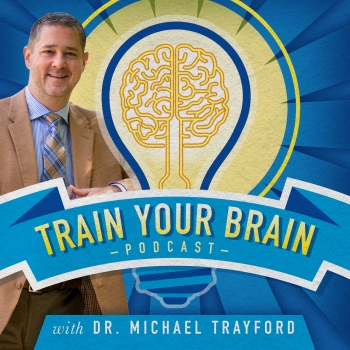Podcast: Play in new window | Download
Good morning and welcome to Episode 056 of the Train Your Brain Podcast with Dr. Michael Trayford. Every Monday we produce a 30-minute episode. Tuesday through Sunday we produce episodes with five-minute tips. Every episode of the Train Your Brain Podcast features a tip, so you can receive pointers 365 days a year that will help enhance the performance of your brain!
Today Dr. Trayford shares brain training tip number 56! All you list-makers out there will love this tip! You might consider shaking things up a bit and instead of making a list of things that you know you should do, make a list of things that you know you shouldn’t do. This exercise gives your brain a new angle from which to strategize your day. Your “Not to Do List” might contain items like: Don’t interrupt others when they are talking. Don’t eat after 7pm, or don’t use cell phone while driving. Instead of constantly measuring yourself by your “to do list,” you will be able to accomplish a lot of self-improvement by focusing on what not to do. Try it today!
If you have any concerns regarding the information and applications discussed in this podcast, please consult your physician and a doctor who is experienced in functional neurology. Michael Trayford DC, DACNB is available for consultation by calling (828) 708-5274. Thanks for listening.
Jason, I’m happy to be here and get my brain trained.
Do you have an on-going to-do list?
Jason: I do! I like to make lists of things I need to do that day, then typically I don’t do all of them.
Well this is good, this is what we should be talking about is the Not to Do List.
I don’t know when I started doing it but. This has made a serious impact on my life.
I’m sure you’ve probably written a to-do-list at some point where you realized you probably have stuff on the list that has not gotten done. Then you just end up transferring stuff from one list to the next and you realize at some point that it probably wasn’t important right?
Jason: Well, that’s the way that I feel better about it yeah!
Generally if it’s not getting done, it’s because of a huge amount of procrastination or it’s simply something that just wasn’t important.
Now to not do list, can be used a couple of different ways. It can be used to clear out some of the tasks that are seemingly trivial on our to-do list. Leaving them on the list is bogging down our brain capacity and they’re creating things like worry and fear, which are the two most damaging emotions for the brain.
This in turn, creates negative long lasting changes in the brain. If you look at these not to do lists, they also invoke creativity and innovation, because we’re no longer bogging down the brain with things that are seemingly not that important.
When it comes to prioritizing, we don’t want to be late for things. So that will help people improve their ability to connect with people and improve relationships.
What do we not want to do sometimes? We don’t want to set expectations too high in certain cases, because we get let down by people’s performance. I do this a lot, because I demand a lot from myself, I demand a lot from others. A lot of times I will be let down.
In my case I need to be mindful to keep an understanding of not setting expectations so high that they can’t be met.
What else do we want to not do?
We want to exercises and not eat a lot of sugar. These things can go on the not to do list.
This helps serve as a reminder of the things we should not be doing. It can also be related to habits like eating bad foods and drinking liquor.
Try to sit down and brain storm about what is not serving you well. Then create a not to do list with them. It will likely become more important than your to-do list.
More and more you’re starting to see successful people like Tim Ferris, that are promoting these not-to-do lists and it’s allowing them to be much more proactive and productive than the actual to-do-list. Try it on for size.
Jason: I’d like to report that this exercise is already done for me by my wife. Except she calls them something different, she call them to-do lists, because she knows if she puts it on there, that it’s not going to get done.
This is a really powerful tip to try out in your own life. Like any of these tips related to lifestyle modification, you want to try them out for a month or so to help change your perspective on things.
Links for this episode:
Click here to learn more about helmets
Learn more at APEX Brain Centers.com
Read the APEX Brain Centers BLOG
Follow us on Facebook
On Google Plus
Follow APEX Brain Centers on Twitter
And here is the Twitter handle for this podcast: @BrainPodcast365
Visit our YouTube Channel

